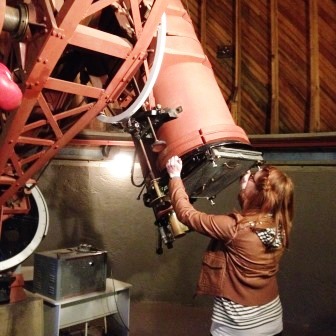 Family Travel Files Ezine Family Vacations Resource Family Travel Files Ezine Family Vacations Resource |
Walking to Pluto: Are We There Yet? Sharing the concept of our tiny solar system with your kids takes some doing but one of the best places to walk to Pluto is at Lowell Observatory in Flagstaff where Pluto was discovered. 
A few weeks ago my daughter and I revisited Lowell Observatory in Flagstaff, Arizona. The last time we were there she was eight years old and Pluto was still a planet. Now Pluto once the focus of the search for “Planet X” is classified as a dwarf planet along with newly discovered Eris. No matter its status, the discovery of Pluto was an important marker in astrological studies.
Here’s the scoop. This year Lowell Observatory is celebrating the 85th anniversary of the discovery of Pluto. In the spring of 1930 a young scientist fulfilling the research dream of Percival Lowell documented the first sighting of the shadowy object which we now know as Pluto.  The story of its discovery and how it was named is worth sharing with your kids. It’s a story of patience, perseverance, creativity and for parents with daughters it is comforting to remember 11-year-old Venetia Burney of Oxford, England suggested that the new planet be named after the Roman god Pluto.
The famous 750-acre mountaintop facility is quietly impressive and guarded by a giant cosmic mountain lion. Real science is being practiced in a nature reserve with staff eager to answer questions about planets, star clusters or pine trees. At the heart of the observatory complex is the Pluto Discovery Telescope actually an astrogragh as our guide reminded us. It is open to the public and it remains the anchor to the Pluto Walk, a 350-foot (107- meter) path illustrating the scale of the solar system with planet stops along the way. The reward for walking to Pluto is to see and touch one of the most famous telescopes in the history of American astronomical research.
The complex has a SlipherVision immersive space theater which enables visitor to journey beyond our solar system. The Cosmic Zoom feature is both thrilling and inspiring. It begins with the Sun and travels out of our galaxy to the very edge of the universe.
More practical for stargazers, Sky Tonight tours of the current night sky exploring the season’s constellations, highlighting visible planets, and adding tidbits about constellation mythology. On a clear night this feature is the perfect precursor to a star watch experience at the Observatory.
Star parties are held onsite throughout the year. Sadly the night we were there the cloud cover made stargazing impossible. Nevertheless walking to Pluto was worth the trip. For those with extra energy it is also possible to take the Galaxy Walk and return via the Universe Trail both provide cosmic perspective that Neil deGrasse Tyson would appreciate.
While we did not spend time on the observatory campus during the day light hours, Lowell offers Daytime Deep Space Tour which varies by day and time of year. On cloudy days when solar viewing is not possible they use an indoor program to highlight dramatic features of the sun. 
The gift shop is populated with tempting items including geeky shirts and gift items. Most irresistible – an artfully clever book explaining Pluto’s dilemma. Pluto's Secret: An Icy World's Tale of Discovery by Margaret Weitekamp, David Devorkin, and Diane Kidd is a must have for children. Whimsical yet informative and entertaining pages convey the true story of how Pluto came to be dubbed a dwarf planet.
Mark your calendar. The Festival of Science & Flagstaff Star Party will be held in September 18-27 with several hands-on activities planned during the 10-day event.
Make it happen. Lowell Observatory 1400 West Mars Hill Road Flagstaff, AZ. (928) 607-1974 or www.lowell.edu
Content and images posted by Nancy Nelson-Duac, Curator of the Good Stuff for the Family Travel Files. Copyright updated 2018.
|